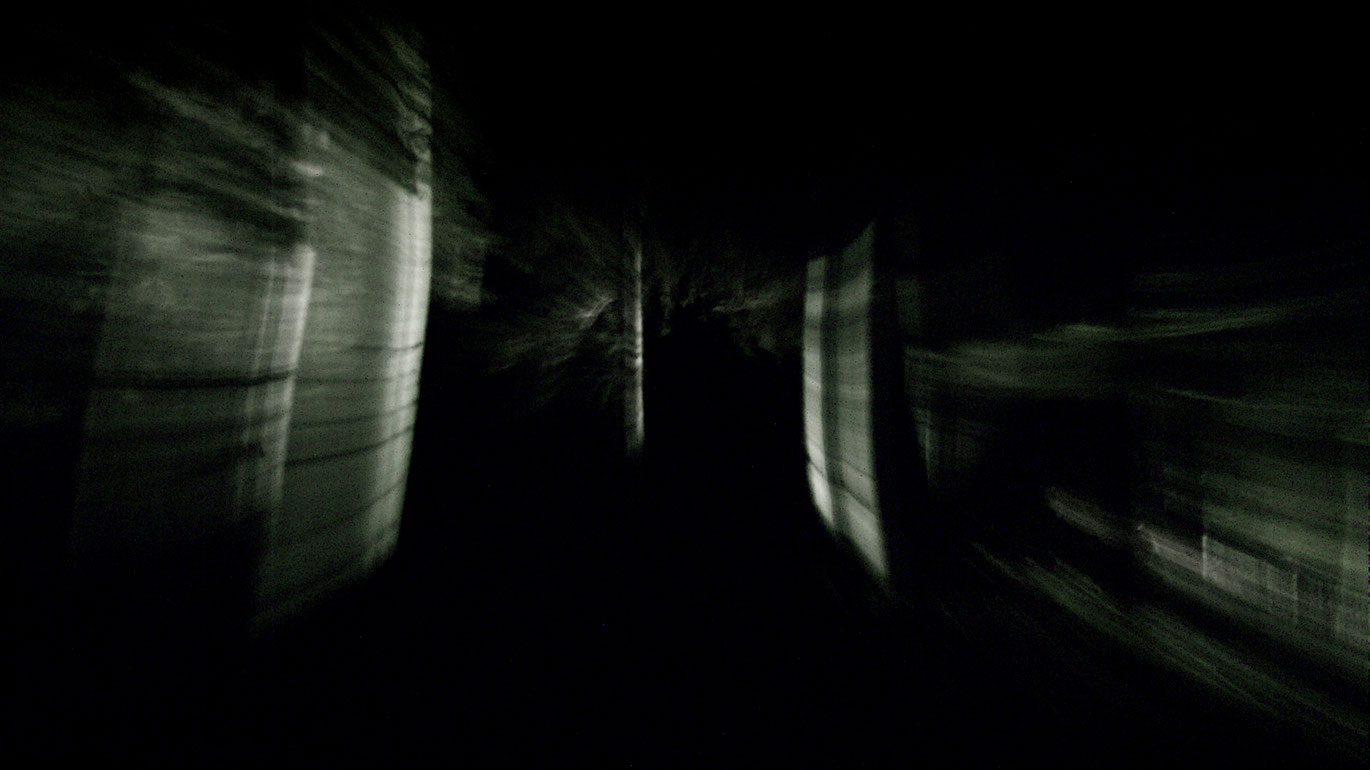VERTIGO RUSH
In the interplay of nature and (optical) machine, the hidden becomes visible. The perverse picture at the end of this work, of an artificial sun made of flashes of light, is no more than the blurring of a choppy film shot taken peering into the depths of a stretch of woods - always included as a visual potential within it. VERTIGO RUSH is a technically extravagant experiment consisting of a series of dolly zooms: a succession of camera movements captured in individual images of forward and backward motion, while simultaneously zooming in the opposite direction. Accelerating this pendulum movement, at first gently and later drastically, intensifies the optical illusion of the space shifting together - and smoothly hands it over to the abstract, transferred to a "dissolving" image.
More so than recalling Hitchcock, who established the technique of the dolly zoom in Vertigo more than half a century ago, VERTIGO RUSH is reminiscent of the clever perception experiments of New American Cinema of the 1960s, especially Michael Snow´s structuralist space and movement studies, one of which would also provide an apt name: Back and Forth. The apparently simple basic situation develops genuine cinematographic impact: While the pure tone soundtrack constantly increases in frequency - at first subliminally, soon thumping nervously - the space expands and condenses as though digitally animated while the virtually uncontrollable play of daylight leaves behind its (documentary) traces even in this system of strict cinematic regulation. With the increase in speed (and the onset of darkness) in the second part of the film, the pictorial space narrows to a nocturnal shock corridor. VERTIGO RUSH flows into a pure frenzy of distorted perspective in the controlled intoxication of speed: the serene velocity of the mechanical gaze unleashed.
(Stefan Grissemann)
Translation: Lisa Rosenblatt
Johann Lurfs psychedelic full-body-experience Vertigo Rush (19 min), left me thrilled at its Viennale premiere. Certainly the use of zoom-in/track-out has been inflationary ever since Vertigo. But 25-year-old Lurf drives it to full excess. The slow acceleration of camera-tracking-speed in combination with subliminal deep bass frequencies makes your skin crawl.
(Maya McKechneay, In: Filmkrant)
Johann Lurfs stunning study VERTIGO RUSH is based on what is called the "Vertigo effect", named after the thriller for which Alfred Hitchcock developed it. (While the camera moves forward on rails, the zoom lens is adjusted to expand the angle of view. The edges of the image remain static, but the dynamic modification of the focal width makes it seem as though the image space gradually gained in depth.) Johann Lurf, a recent graduate of the Academy of Fine Arts in Vienna, where he studied with Harun Farocki, usues this technique, also called „dolly zoom“, for a structural analysis of cinematigraphic processes. For this purpose, the filmmaker set up a highly elaborate technical arrangement: he installed rails in the woods on which a camera moves, operated by a computer. While the camera repeatedly moves back and forth, the lens continually zooms out and in. This process is gradually accelerated. The pace of the forward and backward movement and the frequency with which the zoom lens is operated are independent of one another, creating both additive and subtractive patterns. Toward the end of the film, a slower recording speed and increasing exposure times mean that all the viewer can see are lines that converge in the center of the picture, a star-like image that recalls the science fiction classic 2001: A Space Odyssey (UK/USA 1986, Stanley Kubrick). To accompany these nature shots, Lurf plays a purely synthetic sine wave tone whose frequency and volume also rise continually. What is fascinating about this „test signal“ is that it sounds different every time the film is presented, testing the limits of the specific sound system and gernerating a different accoustic event at each location. To the film-historic references we already mentioned we shouls add 1960s structural film. Most importantly, Lurf‘s film suggests the influence of the experiments conducted by the Canadian artist Michael Snow; the affinities between VERTIGO RUSH and films by Snow such as (Back and Forth, 1969) and La Région Centrale (1971) are unmistakable.
(Norbert Pfaffenbichler in the catalogue for Cineplex, Secession Vienna)
Jury Argument: Best Int'l Experimental Short, Leeds Film Festival 2008 (Award)
Jurybegründung Diagonale 2008 / Preis für Innovatives Kino (Award)
JURY Jury-Begründung film:riss 2008 / Preis für Besten Kunstfilm (Award)
Bert Rebhandl / FAZ (Award)
Bert Rebhandl / Frankfurter Allgemeine Zeitung
VERTIGO RUSH
2007
Austria
19 min



